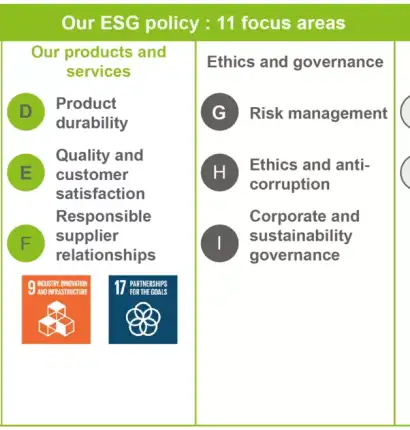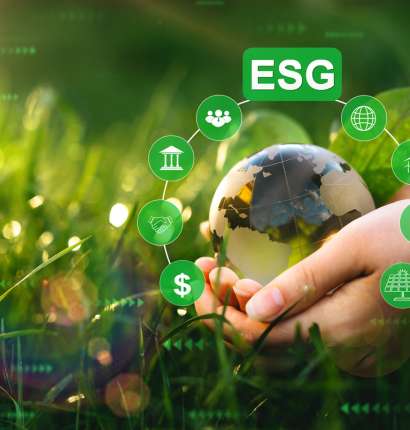In this article, you’ll gain an understanding of the nuances between sustainability and ESG, and discerning their distinct implications for businesses.
Understanding Sustainability and ESG
Sustainability
¹Sustainability refers to the ability to meet present needs without compromising the ability of future generations to meet their own needs. It encompasses economic, social, and environmental aspects. Sustainability aims to create a balance between economic growth, social progress, and environmental protection. This means that sustainable businesses not only prioritize profitability but also consider the well-being of their employees, the communities they operate in, and the planet as a whole. This will benefit all stakeholders in the long-term.
ESG
ESG, on the other hand, is a framework used to evaluate a company’s performance in three key areas: environmental, social, and governance. The environmental aspect focuses on a company’s impact on the planet, including its efforts to reduce carbon emissions, conserve resources, and promote sustainable practices. The social aspect examines how a company interacts with its employees, customers, suppliers, and the broader community. It includes factors such as labor practices, human rights, diversity and inclusion, and community engagement. The governance aspect looks at a company’s internal policies, procedures, and leadership structure to ensure transparency, accountability, and ethical behavior.
Key Components
Key Components of Sustainability
Sustainability is a multifaceted concept that encompasses several key components. These components include:
(1) Environmental Stewardship: Sustainable businesses prioritize the protection and preservation of the environment. They implement practices to minimize pollution, reduce waste, and conserve natural resources. This may involve investing in renewable energy sources, implementing recycling programs, or adopting sustainable supply chain practices.
(2) Social Responsibility: Sustainable businesses recognize their responsibility towards society. They prioritize the well-being of their employees, promote fair labor practices, and contribute positively to the communities they operate in. This may include providing a safe and inclusive work environment, supporting local charitable initiatives, or engaging in philanthropic activities.
(3) Economic Viability: Sustainability is not just about being environmentally and socially responsible; it also makes good business sense. Sustainable businesses focus on long-term profitability by incorporating sustainable practices into their operations. This may involve adopting innovative technologies, improving energy efficiency, or developing products and services that meet the evolving needs of customers.
Key Components of ESG
ESG focuses on three key components: environmental, social, and governance. These components are used as a framework to assess a company’s performance in terms of sustainability. Let’s take a closer look at each of them:
(1) Environmental: The environmental component of ESG looks at a company’s impact on the planet. It considers factors such as carbon emissions, water usage, waste management, and biodiversity. Companies that prioritize environmental sustainability often implement measures to reduce their carbon footprint, minimize waste generation, and conserve natural resources.
(2) Social: The social component of ESG assesses how a company interacts with its employees, customers, suppliers, and the broader community. It examines factors such as labor practices, human rights, diversity and inclusion, customer satisfaction, and community engagement. Companies that prioritize social sustainability create a positive work environment, promote diversity and inclusion, and actively contribute to the well-being of the communities they operate in.
(3) Governance: The governance component of ESG looks at a company’s internal policies, procedures, and leadership structure. It assesses factors such as board composition, executive compensation, risk management, and transparency. Companies with strong governance practices prioritize ethical behavior, accountability, and transparency in their decision-making processes.
What’s the difference between ESG and sustainability?
In the contemporary business landscape, the terms ‘Sustainability’ and ‘Environmental, Social, and Governance (ESG)’ frequently overlap, generating discourse on their interchangeable usage, but they actually have distinct meanings. ESG stands for Environmental, Social, and Governance, and refers to a set of criteria that investors use to evaluate a company’s performance in these areas. It focuses on how a company operates and manages its impact on the environment, its relationships with its employees, customers, and communities, and the effectiveness of its governance structures.

“ESG criteria are a subset of sustainability metrics that are linked to financial performance.”
On the other hand, sustainability is a broader concept that encompasses ESG but also includes considerations of long-term viability and resilience. It involves balancing economic, environmental, and social factors to ensure the well-being of current and future generations.
ESG (Environmental, Social, and Governance) and sustainability are related concepts but differ in focus and scope.
- Focus:
- ESG primarily focuses on evaluating a company’s performance and behavior in three key areas: environmental impact, social responsibility, and governance practices. It assesses how well a company manages its environmental risks, treats its employees and other stakeholders, and maintains effective governance structures.
- Sustainability, on the other hand, is a broader concept that encompasses ESG factors but extends beyond them. Sustainability refers to the ability of an organization to meet its present needs without compromising the ability of future generations to meet their own needs. It involves considering the economic, social, and environmental aspects of decision-making to ensure long-term viability and resilience.
- Scope:
- ESG factors typically focus on specific metrics and indicators related to environmental performance (E), social responsibility (S), and governance practices (G). These factors are often quantifiable and measurable, allowing for comparative analysis between companies.
- Sustainability, on the other hand, encompasses a broader set of considerations beyond ESG metrics. It includes aspects such as sustainable development, resource efficiency, social equity, and intergenerational equity. Sustainability initiatives may involve long-term strategic planning, stakeholder engagement, and systemic changes to business models and practices.
While ESG is primarily concerned with corporate performance and the interests of stakeholders, sustainability takes a more holistic approach by considering the broader impacts and implications of business activities on society and the planet.
In summary, ESG is a subset of sustainability, focusing specifically on corporate practices and their impact on stakeholders.
The Importance of Differentiating Between ESG factors and Sustainability
Differentiating between ESG factors and sustainability is important for several reasons:
Clarity in Reporting: Clear differentiation between ESG factors and sustainability ensures accurate and transparent reporting. Companies, investors, and stakeholders need to understand the specific aspects of ESG and sustainability being addressed in reports, initiatives, and strategies to make informed decisions.
Targeted Action: Distinguishing between ESG factors and sustainability allows for targeted action and focus. While ESG factors primarily focus on specific environmental, social, and governance criteria, sustainability encompasses a broader set of goals and principles. Understanding this difference helps organizations prioritize actions and initiatives accordingly.
Comprehensive Understanding: Recognizing the distinctions between ESG and sustainability promotes a more comprehensive understanding of corporate responsibility and performance. Sustainability encompasses broader concepts such as long-term viability, resilience, and holistic impact, whereas ESG factors focus on specific criteria within each category. A nuanced understanding of both concepts is essential for effective decision-making and strategy development.
Investment and Risk Assessment: Investors and stakeholders increasingly rely on ESG data to assess investment opportunities and risks. Clear differentiation between ESG and sustainability allows investors to evaluate companies based on specific ESG criteria relevant to their investment goals, risk tolerance, and values. It also facilitates better risk assessment by identifying potential gaps or areas of improvement in sustainability performance.
Strategic Alignment: Understanding the differences between ESG and sustainability helps organizations align their strategies and initiatives with broader sustainability goals and principles. While ESG factors provide valuable insights into specific areas of performance, sustainability serves as a guiding framework for achieving long-term environmental, social, and economic objectives. By aligning ESG efforts with broader sustainability goals, companies can create more holistic and impactful strategies.
Conclusion
In conclusion, ESG and sustainability are intertwined yet distinct concepts. ESG provides a framework for evaluating and managing specific factors in environmental, social, and governance performance, while sustainability encompasses a broader perspective focusing on the long-term viability and resilience of organizations and societies. Both are crucial in driving responsible business practices, mitigating risks, and creating positive societal and environmental impacts. Understanding the differences and interconnections between ESG and sustainability is essential for businesses, investors, and stakeholders to navigate the evolving landscape of sustainable development effectively.
Understanding these differences also promotes clarity in reporting, enables targeted action, fosters a comprehensive understanding of corporate responsibility, facilitates investment and risk assessment, and supports strategic alignment with broader sustainability goals.
Read More
You might be interested
References/Article sources:
¹In 1987, the United Nations Brundtland Commission defined sustainability as “meeting the needs of the present without compromising the ability of future generations to meet their own needs.” Source: un.org/en/academic-impact/sustainability#. Retrieved February 20, 2024













